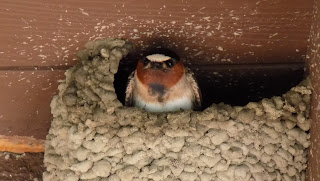 |
| A praying mantis kills a hummingbird in San Juan Capistrano. Photo by Kris Okamoto |
Original Source:
Martin Nyffeler, Michael R. Maxwell, J. V. Remsen, Jr.
Bird predation by praying mantises: a global perspective
The Wilson Journal of Ornithology (2017) 129(2): 331-344 | DOI: 10.1676/16-100.1
A study by zoologists from Switzerland and the United States shows: praying mantises all over the globe also include birds in their diet. The Wilson Journal of Ornithology has just published the results.
Praying mantises are carnivorous insects with powerful raptorial front legs that usually depend on arthropods such as insects or spiders as their primary prey. Rather infrequently, they have also been witnessed eating small vertebrates such as frogs, lizards, salamanders or snakes. A new study by the zoologists Martin Nyffeler (University of Basel), Mike Maxwell (National University, La Jolla, California), and James Van Remsen (Louisiana State University) now shows that praying mantises all over the world also kill and eat small birds.
Decades ago, several alien species of large mantises (e.g., Mantis religiosa and Tenodera sinensis) were released across North America as biological pest control agents. These imported species now constitute a new potential threat to hummingbirds and small passerine birds. However, there are also large native mantises that prey on birds. “Our study shows the threat mantises pose to some bird populations. Thus, great caution is advised when releasing mantises for pest control,” says Nyffeler.
Further information
PD Dr. Martin Nyffeler, University of Basel, Department of Environmental Sciences, Tel. +41 61 702 07 03, email: martin.nyffeler@unibas.ch
Feeding on birds is a global pattern
The researchers gathered and documented numerous examples of bird-eating mantises. In a systematic review, they were able to show that praying mantises from twelve species and nine genera have been observed preying on small birds in the wild. This remarkable feeding behavior has been documented in 13 different countries, on all continents except Antarctica. There is also great diversity in the victims: birds from 24 different species and 14 families were found to be the prey of mantises. “The fact that eating of birds is so widespread in praying mantises, both taxonomically as well as geographically speaking, is a spectacular discovery," comments Martin Nyffeler from the University of Basel and lead author of the study.Praying mantises pose a threat to small birds
The researchers assembled 147 documented cases of this feeding behavior from all over the world. However, more than 70 percent were reported in the US, where praying mantises often capture birds at hummingbird feeders or plants pollinated by hummingbirds in house gardens. Consequently, hummingbirds make up the vast majority of birds killed by praying mantises, with the Ruby-throated Hummingbird (Archilochus colubris) being a particularly frequent victim.Decades ago, several alien species of large mantises (e.g., Mantis religiosa and Tenodera sinensis) were released across North America as biological pest control agents. These imported species now constitute a new potential threat to hummingbirds and small passerine birds. However, there are also large native mantises that prey on birds. “Our study shows the threat mantises pose to some bird populations. Thus, great caution is advised when releasing mantises for pest control,” says Nyffeler.
Further information
PD Dr. Martin Nyffeler, University of Basel, Department of Environmental Sciences, Tel. +41 61 702 07 03, email: martin.nyffeler@unibas.ch

